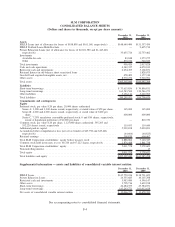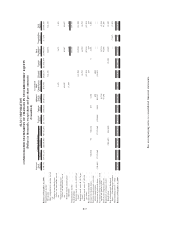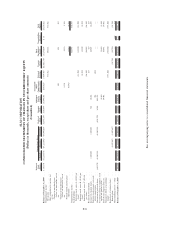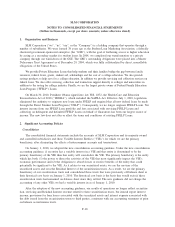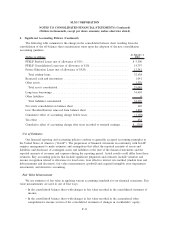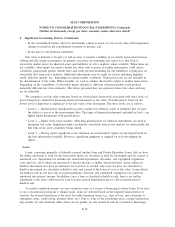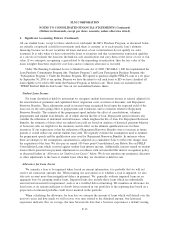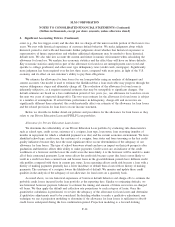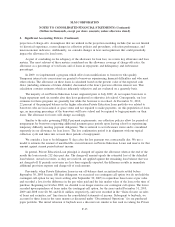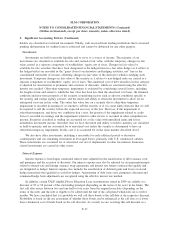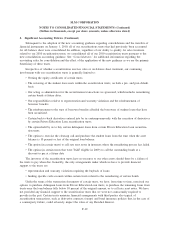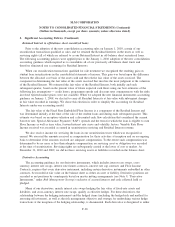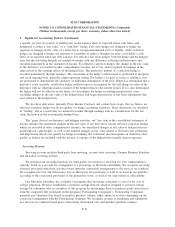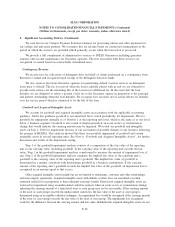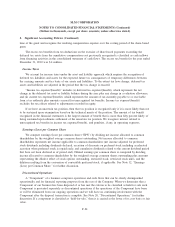Sallie Mae 2010 Annual Report Download - page 117
Download and view the complete annual report
Please find page 117 of the 2010 Sallie Mae annual report below. You can navigate through the pages in the report by either clicking on the pages listed below, or by using the keyword search tool below to find specific information within the annual report.2. Significant Accounting Policies (Continued)
event (e.g., the loss trigger event) and the date that we charge-off the unrecoverable portion of that loan is two
years. We start with historical experience of customer default behavior. We make judgments about which
historical period to start with and then make further judgments about whether that historical experience is
representative of future expectations and whether additional adjustment may be needed to those historical
default rates. We also take into account the current and future economic environment when calculating the
allowance for loan loss. We analyze key economic statistics and the effect they will have on future defaults.
Key economic statistics analyzed as part of the allowance for loan loss are unemployment rates (total and
specific to college graduates) and other asset type delinquency rates (credit cards, mortgages). Significantly
more judgment has been required over the last three years, compared with years prior, in light of the U.S.
economy and its effect on our customer’s ability to pay their obligations.
We estimate the allowance for loan losses for our loan portfolio using an analysis of delinquent and
current accounts. Our model is used to estimate the likelihood that a loan receivable may progress through the
various delinquency stages and ultimately charge off. The evaluation of the allowance for loan losses is
inherently subjective, as it requires material estimates that may be susceptible to significant changes. Our
default estimates are based on a loss confirmation period of two years (i.e., our allowance for loan loss covers
the next two years of expected charge-offs). The two-year estimate for the allowance for loan losses is subject
to a number of assumptions. If actual future performance in delinquency, charge-offs and recoveries are
significantly different than estimated, this could materially affect our estimate of the allowance for loan losses
and the related provision for loan losses on our income statement.
Below we describe in further detail our policies and procedures for the allowance for loan losses as they
relate to our Private Education Loan and FFELP Loan portfolios.
Allowance for Private Education Loan Losses
We determine the collectability of our Private Education Loan portfolio by evaluating risk characteristics
such as school type, credit scores, existence of a cosigner, loan type, loan status, loan seasoning (number of
months in repayment for which a scheduled payment was due) and the current economic environment. We have
identified school type, credit score, the existence of a cosigner, loan status and loan seasoning as the key credit
quality indicators because they have the most significant effect on our determination of the adequacy of our
allowance for loan losses. The type of school borrowers attend can have an impact on their job prospects after
graduation and therefore affects their ability to make payments. Credit scores are an indicator of the credit
worthiness of a borrower and the lower the credit score the more likely it is the borrower will be unable to make
all of their contractual payments. Loan status affects the credit risk because a past due loan is more likely to
result in a credit loss than a current loan and because loans in the grace/deferment periods have different credit
risk profiles compared with those in current pay status. Loan seasoning affects credit risk because a loan with a
history of making payments generally has a lower incidence of default than a loan with no history of making
payments. The existence of a cosignor lowers the likelihood of default. We monitor and update these credit
qualities in the analysis of the adequacy of our allowance for loan losses on a quarterly basis.
As noted above, we use historical experience of borrower default behavior and charge-offs to estimate the
probable credit losses incurred in the loan portfolio at the reporting date. Similar to estimating defaults, we
use historical borrower payment behavior to estimate the timing and amount of future recoveries on charged
off loans. We then apply the default and collection rate projections to each category of loans. Once the
quantitative calculation is performed, we review the adequacy of the allowance for loan losses and determine
if qualitative adjustments need to be considered. In deciding whether to make a qualitative adjustment, one
technique we use is projection modeling to determine if the allowance for loan losses is sufficient to absorb
credit losses anticipated during the loss confirmation period. Projection modeling is a forward-looking
F-14
SLM CORPORATION
NOTES TO CONSOLIDATED FINANCIAL STATEMENTS (Continued)
(Dollars in thousands, except per share amounts, unless otherwise stated)


